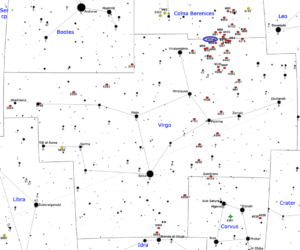Messier 90 (M90) is a spiral galaxy located in the constellation Virgo. It is a member of the Virgo Cluster. Messier 90 is one of the largest and brightest spirals in the Virgo Cluster. The galaxy has an absolute magnitude of -22, which makes it intrinsically brighter than Andromeda (M31). Its tightly wound spiral arms do not show any signs of star formation, except in regions near the darker dust lanes in the inner part of the galaxy’s disk.
Messier 90 is a blueshifted galaxy, one moving in our direction, in contrast to most other galaxies, which are redshifted and moving away. The only Messier galaxy approaching us at a higher velocity than M90 is M86. M90 is likely moving through the Virgo Cluster at an exceptionally high velocity, which means that the galaxy may be in the process of escaping the cluster. The spiral arms of M90 appear featureless, not dotted with star forming regions like other spiral galaxies. For this reason, M90 is classified as an anemic galaxy and serves as a prototype for this class of galaxies.
| Description | |
| Visible From Pacific Northwest | January to May |
| Best Time To Observe | May |
| Minimum Size Of Viewing Device | Small Telescope |
| Object Type | Spiral Galaxy |
| Designations | Messier 90, M90, NGC 4569, Arp 76, PGC 42089, UGC 7786, 1E 1234.2+1326, IRAS 12343+1326, 2MASX J12364981+1309463, MCG+02-32-155, VPC 1082, VCC 1690, UZC J123649.7+130946, Z 70-192, Z 1234.3+1326 |
| Right Ascension | 12h 36m 49.8s |
| Declination | +13°09’46” |
| Constellation | Virgo |
| Number Of Stars | 1 Trillion |
| Apparent magnitude | +10.26 |
| Apparent dimensions | 9′.5 x 4′.4 |
| Object Radius | 82,500 light years |
| Distance From Earth | 58.7 million light years |
History
Messier 90 was discovered by Charles Messier on March 18, 1781, along with the globular cluster Messier 92 in Hercules constellation and Virgo Cluster members Messier 84, Messier 86, Virgo A (M87) and Messier 89 in Virgo constellation, and Messier 85, Messier 88 and Messier 91 in Coma Berenices. Messier described M90 as a “nebula without star, in Virgo,” adding that “its light is as faint as the preceding, No. 89.”
William Herschel observed M90 in April 1784 and noted that it was “pretty large, with a nucleus, perhaps cometic, but moonlight permits not to give a proper description.”
John Herschel listed M90 in the General Catalogue as GC 3111, describing it as “pretty large; brighter toward the middle where there is a nucleus.”
Locating M90 In The Sky
Messier 90 is located about 1.5 degrees from the Virgo Cluster subgroup centred on Messier 87, right on the border with the constellation Coma Berenices, near the centre of the Virgo Cluster. The centre is positioned roughly halfway between the bright stars Denebola in Leo and Vindemiatrix in Virgo. M90 can be found 1.5 degrees to the northeast of M87.

Viewing M90
It can be seen in 10×50 binoculars under exceptionally good conditions. In small telescopes, it appears as a bright, oval-shaped patch of light. 8-inch telescopes reveal the galaxy’s bright core surrounded by a patch of nebulosity. The spiral structure can be seen in large amateur telescopes.
Photographing M90
Messier 90 is unique as it can be photographed really high in the sky and can be imaged with both a camera and CMOS technology. This location of overhead might be tough for some scopes due to the different angles required for capture, but this is definitely a target than is worth imaging with about 3 to 4 hours of total exposure time at most for all of the photographs.
https://www.cloudynights.com/topic/709579-messier-90/
Sources And Further Reading
Descriptions of all of Messier Objects can be found here.
https://www.nasa.gov/feature/goddard/2018/messier-90

Be the first to comment on "Messier 90"